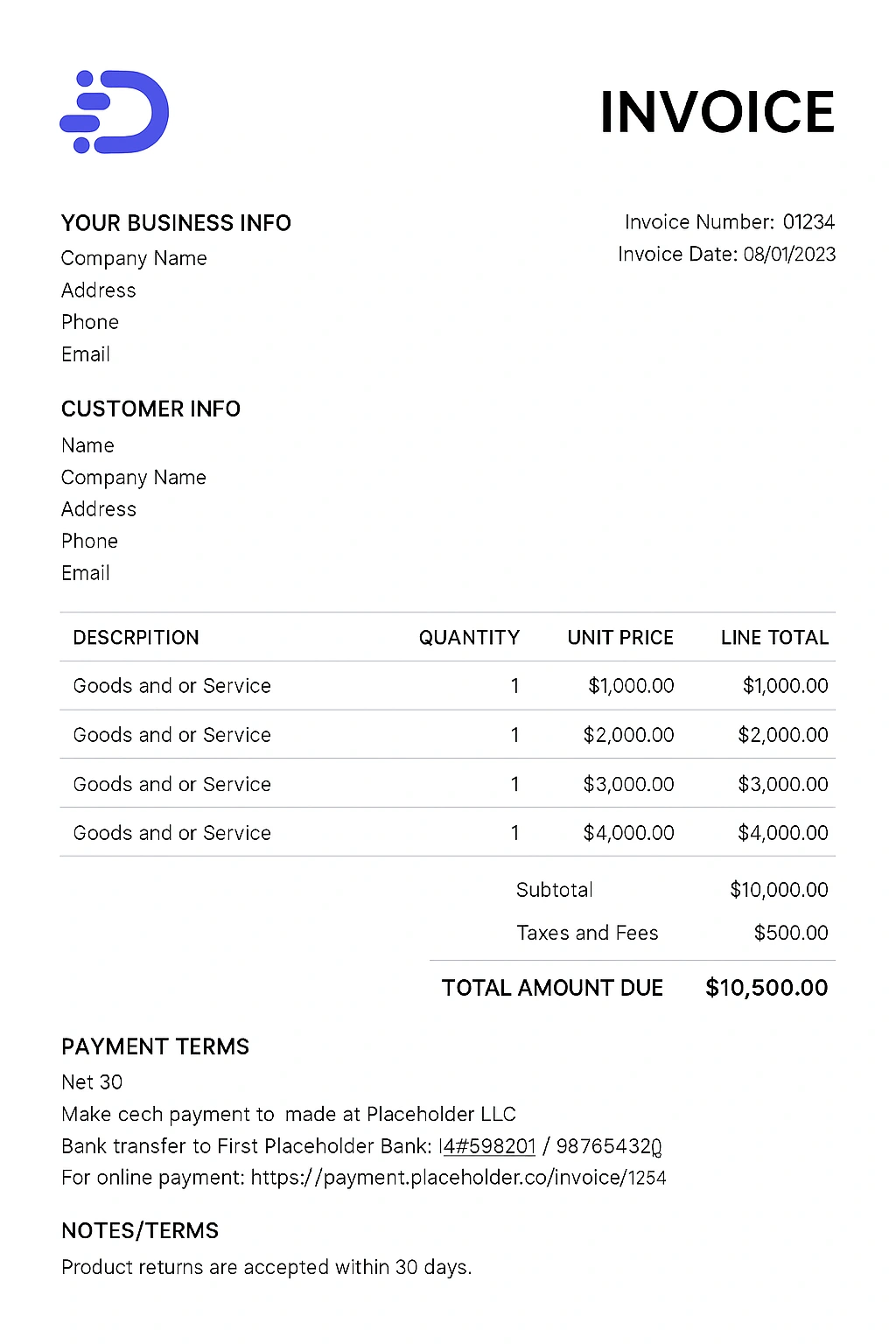An invoice is issued after the goods or services have been delivered, serving as a formal request for payment. A quote is a cost estimate provided before work begins, giving customers a clear idea of pricing, terms, and scope so they can make a decision.
What Is an Invoice
An invoice is a formal document that a business issues to a customer to request payment for goods or services that have been provided. It serves as both a financial record and a legal agreement, outlining exactly what was delivered, the cost, and the payment terms.
Typically, an invoice includes details such as the seller’s information, the buyer’s details, a breakdown of products or services rendered, quantities, unit prices, total amount due, payment due date, and accepted payment methods.
Invoices ensure that companies get paid on time and help maintain accurate financial records for accounting, taxes, and audits. Beyond payment collection, invoices build professionalism and trust, as they provide customers with a clear, itemized summary of the transaction.
Depending on the business model, invoices can also include additional information such as discounts, late payment fees, or purchase order numbers.
What Is an Invoice Used for
An invoice is used as a formal request for payment and as a record of a business transaction between a seller and a buyer. Its primary purpose is to let the customer know how much they owe for goods or services received, under what terms, and by when payment is due.
Invoices help businesses track revenue, manage cash flow, and prepare accurate financial statements. From a legal standpoint, invoices can act as evidence of a transaction in case of disputes, audits, or tax filings.
They are also useful for maintaining transparency with clients, as they provide a clear breakdown of costs, which helps prevent misunderstandings. In many industries, invoices are used not just for requesting payments but also for monitoring customer payment history, applying discounts, charging late fees, or aligning with purchase orders.
What Is Included in an Invoice
An invoice is designed to give both the seller and the buyer a clear record of the transaction while outlining the exact details needed for payment. To be effective, it must contain specific elements that not only help the customer understand what they are being charged for but also assist the business in tracking sales, managing cash flow, and staying compliant with accounting standards. While layouts can vary depending on industry or business type, most invoices share a set of common components that ensure accuracy and professionalism.
Here’s what is typically included in an invoice:
- Business details – Seller’s company name, logo, address, phone number, and email
- Customer information – Buyer’s name, company (if applicable), and contact details
- Invoice number – A unique identifier to track and organize invoices
- Invoice date and due date – The issue date and the deadline for payment
- Itemized list of goods or services – Descriptions, quantities, and unit prices
- Subtotal, taxes, discounts, and total amount due – Clear breakdown of charges
- Payment terms – Instructions such as “Net 15,” “Net 30,” or “Due on receipt”
- Accepted payment methods – Bank transfer, credit card, digital wallet, etc.
- Additional notes or terms – Purchase order numbers, late fees, or special instructions

What Is a Quote
A quote is a formal document a business provides to a potential customer before work begins, outlining the estimated cost of products or services. Unlike an invoice, which is a request for payment after delivery, a quote serves as an offer and gives the client a clear idea of what they can expect to pay, under what terms, and within what timeframe.
A well-prepared quote typically includes details such as the scope of work, itemized pricing, quantities, applicable taxes, and the validity period of the offer, ensuring both parties understand the expected costs before committing.
Quotes are especially important in industries like construction, consulting, or custom services where pricing can vary depending on materials, labor, and project requirements. They help clients make informed decisions and also protect businesses, as they set clear expectations upfront, reducing the risk of disputes once the work is underway.
What Is a Quote Used for
A quote is used to give potential customers a clear and upfront estimate of how much a product or service will cost before they agree to move forward. Its main purpose is to set expectations and outline pricing, scope, and terms so the customer can make an informed decision.
Businesses use quotes to demonstrate transparency, build trust, and increase the likelihood of winning contracts or projects, especially in industries where costs vary based on labor, materials, or customization. A quote also serves as a reference point for both parties if the client accepts it, the agreed-upon terms can later be converted into a contract or invoice.
Key Differences Between an Invoice vs Quote
An invoice and a quote may look similar at first glance since both are formal business documents, but they serve very different purposes in the sales process. A quote comes at the beginning of a transaction, providing an estimated cost for goods or services before any work is done, while an invoice comes at the end, serving as a request for payment once the work is completed. Quotes are used to inform and persuade customers, while invoices are used to collect payment and maintain accurate financial records. Understanding the differences between the two ensures smoother client communication, proper documentation, and better cash flow management.
Here’s a table highlighting the key differences between an invoice and a quote:
Ready to streamline your payment operations?
Discover the hidden automation in your payment, billing and invoicing workflows. Talk to our experts for a free assement!

